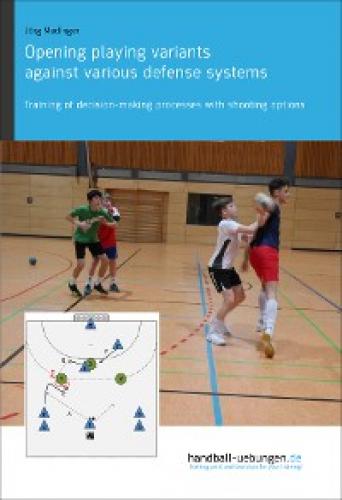to the pivot following different initial actions are a factor of success against any defense system. The players initially play against offensive defense systems; usually, there are large gaps which can be used by the pivot, and passing the ball to the pivot is possible very frequently.
A3.1 Preparatory exercise 1: Passing to the pivot
Setting:
- The players each have a ball and stand on both back positions. They should stand broadly (close to the side line).
- One pivot and one defense player each stand on either side of the 7-meter line.
Basic position of the pivot:
-
stands in basic position, placing a screen next to
, and stretching the hand upward that is further away from the defense player, to catch a pass (figure 2).
-
should keep the defense player behind by using his body and a proper leg posture.
-
must not use his left arm for screening off
(in the example), but rather hold it in front of his body.
(Figure 1)
Course:
-
in direction of the latter’s hand stretched upward.
-
should catch the ball with one hand (ideally) (A).
- As soon as he has caught the ball,
turns around and shoots at the goal (B).
- Afterwards, the players start the sequence over on the other side, with
and
(C).
(Figure 2)
Instructions for the two defense players:
- At the beginning of the exercise, the defense player should allow the catching, turning and shooting moves.
- In the next step, the defense player should increase the pressure right before the pivot receives the pass and try to leave the screen.
- As soon as the pivot has received the ball, the defense player should vigorously try to prevent him from shooting at the goal.
The pivots should place the screening in such a way that the defense player always stands behind them.
A3.2 Preparatory exercise 2: Finding the right timing for a pass
Setting:
- The two foremost defense players (
and
) initially stand at the 9-meter line.
- The pivot and the respective defense player (
and
) start at the 7-meter line.
(Figure 1)
Course:
-
passes the ball into the running path of
(A).
-
, so that
must sidestep towards the outer side in order to adjust his position (B).
(Figure 2)
→
places a screen next to
(see previous exercise – figure 2).
- If the passing path to the inner side, i.e. to
, is unobstructed,
directly (C).
- If the passing path to the inner side is obstructed,
should try to break through to the inner side 1-on-1 (D).
→
should take care that his throwing hand is never blocked so that he can play a pass anytime.
-
should try to prevent a breakthrough to the inner side (E).
- As soon as the passing path to
has become free during the 1-on-1 action, the pass should be played (F) (figure 3).
(Figure 3)
, so that he ideally can catch it with one hand (figure 4).
(Figure 4)
-
catches the ball, turns around immediately, and shoots at the goal (not in the figure).
- Afterwards, the players repeat the course on the other side.
may take a short break;
places the screen next to
